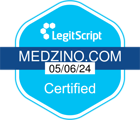Information

Reviewed by Dr Roy Kedem, MD
Information last reviewed 10/28/19
About
What is rosacea?
Rosacea (rose-AY-sha) is a chronic condition causing redness and irritation of the skin, usually on the nose, cheeks and forehead. It may present with pimples and can affect the chest, back and ears in addition to the face. Over time, skin thickening and eye problems may develop.
Because rosacea may cause a variety of symptoms, the American Academy of Dermatology has established four subtypes:
- Erythematotelangiectatic rosacea: redness, flushing and visible blood vessels
- Papulopustular rosacea: acne-like breakouts with redness and swelling
- Phymatous rosacea: skin thickening accompanied by a bumpy texture
- Ocular rosacea: red, irritated eyelids which may swell or appear to have a sty
Although rosacea is usually associated with fair skin, those of any skin color may develop it. It is found more often in women than men, particularly during menopause, and mostly affects middle-aged and older adults.
Causes
What causes rosacea?
The exact causes of rosacea are still not known. Some evidence suggests the redness and flushing may be caused by blood vessels with a tendency to dilate too easily. Recent research has also revealed additional potential contributors:
- Heredity: Rosacea often runs in families, which may indicate potential genetic factors.
- Immune response: In cases of acne-like rosacea, most people demonstrated an immune system overreaction to the bacterium bacillus oleronius.
- H pylori intestinal infection: Although there is no proof an H. pylori infection causes rosacea, it is quite commonly found in rosacea sufferers. However, many people with an H. pylori infection do not exhibit rosacea symptoms.
- Overabundance of demodex mites: Demodex mites live on everyone’s skin, favor the nose and cheeks and carry Bacillus oleronius. Some people with an overabundance of these mites go on to develop rosacea, while others do not.
- Cathelicidin protein processing: While the protein cathelicidin normally protects skin from infection, the body’s improper processing of it may induce redness and swelling.
- Systemic inflammation: Although no causal links have been found, rosacea has been associated with a number of serious conditions known to cause systemic inflammation.
While the underlying causes of rosacea remain something of a mystery, many known factors can trigger and/or intensify a rosacea flare-up. These include:
- Heat, including hot weather, baths and showers, and that from exercise
- Other weather factors including sunlight, wind and very cold temperatures
- Various foods including; hot or spicy food, pungent vegetables such as tomatoes and hot peppers, and citrus fruits
- Beverages which can dilate blood vessels including; alcohol, hot tea and hot coffee
- Menopause
- Bacteria which may include B. oleronius and H. pylori
- Long-term use of topical steroids
- Emotional stress
Symptoms
What are the symptoms of rosacea?
Rosacea is typified by frequent redness and flushing of the face, usually in the areas of the cheeks, nose, chin and forehead. Skin may also have a burning sensation, become extremely sensitive to cosmetics and feel swollen.
The symptoms of rosacea can also go well beyond reddening of the face. Because the disease can present in numerous ways, four subtypes have been established. Many people exhibit symptoms of multiple subtypes, and not all symptoms in a subtype need be present to establish a diagnosis. It should be noted that each subtype requires a different treatment protocol.
Subtype 1: Flushing, redness, visible blood vessels:
- A tendency to easily flush or blush
- Redness in the center of the face
- Skin is chronically dry, rough or becomes scaly
- Broken blood vessels are visible
- Skin becomes very sensitive and may sting or burn, particularly with the application of cosmetics
Subtype 2: Acne-type breakouts:
- Breakouts resembling acne, usually appearing in reddened facial areas. These breakouts may come and go
- Skin appears oily, may sting and becomes very sensitive
- Visible spider veins and broken blood vessels
- Development of raised skin patches, termed “plaques”
Subtype 3: Skin thickening
- Rare, and usually develops after another subtype of rosacea is already present
- Skin develops a bumpy texture
- Skin becomes thicker, particularly on the nose, but may appear on the ears, chin, forehead and cheeks as well
- Oily skin with enlarged pores
- Visible spider veins and broken blood vessels
Subtype 4: Eye involvement
- Eyes appear bloodshot and watery
- Eyes may feel dry, burn, itch or sting
- Vision worsens or becomes blurry
- Increased light sensitivity
- Feeling of “sand in the eyes”
- Cysts and/or broken blood vessels on the eyelids
It is important to note that rosacea can progress from one subtype to others. If you have rosacea, closely monitor your skin for any signs of progression. Any signs of skin thickening or eye involvement should be addressed with your physician immediately as early treatment is imperative.
Diagnosis
How is rosacea diagnosed?
There are no definitive medical tests to confirm rosacea. Rather, your doctor will examine your skin and eyes, in addition to asking many questions related to the typical presentation and symptoms of rosacea. Your doctor may recommend medical tests to rule out other conditions which can look similar to rosacea, such as lupus and allergic reactions.
Treatment
What is the treatment for rosacea?
While there is no cure for rosacea, a variety of treatment options can improve your skin’s appearance and comfort.
As a baseline, most doctors will recommend:
- Identification and avoidance of your common rosacea triggers
- Daily use of broad-spectrum sunscreen (SPF 30 or higher) as well as general avoidance of direct sunlight
- Use of only gentle or “sensitive” skincare products and cosmetics, such as those labeled as hypoallergenic.
- Use of only gentle skincare products and cosmetics, such as those labeled for sensitive skin and as allergen-free.
Beyond this basic approach, the recommended course of treatment will depend on the subtype(s) of your rosacea and other considerations. Together, you and your doctor will devise a customized plan, which may include multiple medications to treat the varying symptoms of each subtype of which you suffer.
Redness
- A brimonidine gel (such as Mirvaso) or an oxymetazoline hydrochloride cream (such as Rhofade) can temporarily reduce redness for as long as 12 hours. Both ingredients are FDA approved for rosacea treatment. Potential side effects from these treatments are usually mild and temporary, and may include increased redness, burning and contact dermatitis.
- Lasers or Intense Pulsed Light (IPL) therapy can address both redness and removal of visible blood vessels. Though expensive, this approach provides more permanent redness reduction, lasting up to three years. Side effects generally include temporary redness and swelling. Selection of an experienced and skilled physician is essential, however, as serious side effects can occur, including burns, skin discoloration, and even permanent scarring.
Acne-type breakouts
- Antibiotics have long been used to help control rosacea. They are not appropriate for long-term use, however, as the development of antibiotic resistance is a serious health concern. Tetracycline antibiotics (such as Sumycin) are the most commonly prescribed for treating rosacea, although minocycline, doxycycline, and erythromycin can also be effective.
- For longer-term treatment, low-dose doxycycline (such as Oracea) addresses the underlying inflammation which leads to rosacea’s papules and pustules. Studies have shown low-dose doxycycline does not lead to antibiotic resistance and has fewer side effects than full-strength antibiotic treatments. These medications are usually well-tolerated and many study participants start to see improvement in as little as three weeks.
- For severe cases, isotretinoin medications (such as Accutane) may be prescribed to reduce both redness and acne-like breakouts. Isotretinoin can cause severe birth defects and must not be taken by women who may become pregnant.
- Applied topically, antibiotic metronidazole gels and creams (such as MetroGel) can reduce both redness and breakouts long-term for some patients. In one study, 77% of participants remained free of flare-ups six months after discontinuing use. Side effects were minimal, but included dryness, stinging and general irritation.
- Sodium sulfacetamide cleansers and creams (such as Ovace) are also antibiotic-based and work to reduce the inflammation leading to rosacea symptoms. Redness can be decreased by 66–83% and breakouts by 65–78%. Although considered safe, alert your doctor if you have a sensitivity to sulfur or kidney disease.
- Also applied topically, azelaic acid treatments (such as Azelaic Acid 15% Gel or Finacea Foam) have been shown to reduce rosacea’s acne-like breakouts in 70–80% of patients, with some experiencing complete clearing. Some tingling or burning may occur at first, usually resolving with continued use. Skin lightening may occur as well, which can be useful for those with rosacea-induced dark patches. If you notice unwanted skin lightening while using azelaic acid, be sure to alert your physician immediately. If you have darker skin, you may want to talk to your physician before considering treatment with azelaic acid.
- A new class of ivermectin-based creams (such as Soolantra), take a completely different approach to reducing the bumps and blemishes of rosacea. Although the exact mechanism of how it works is unknown, ivermectin is thought to have anti-parasitic and anti-inflammatory properties, which may lead to a reduction in over-abundance of demodex mites in some rosacea patients. Results are often seen quickly, with a 27% reduction in bumps seen in just two weeks, and up to a 75% reduction by week 12. Side effects were also less severe than other topical treatments.
- As with redness, lasers or Intense Pulsed Light (IPL) therapy can also address acne-like rosacea symptoms. One to five treatments are generally needed. To reduce the risk of serious side effects, including burns, skin discoloration, and even permanent scarring, choose a board-certified doctor experienced with utilizing these techniques for the treatment of rosacea.
Skin thickening
- Skin thickening with rosacea is far more common in men. Isotretinoin medications (such as Accutane) cannot reverse skin thickening but can be effective in preventing it from worsening. Isotretinoin can cause severe birth defects and must not be taken by women at risk of becoming pregnant.
- If thickened skin needs to be removed for either cosmetic or medical reasons, surgery is the only option. In the nasal area, skin thickening can interfere with breathing; in the eye area, vision problems may occur. Surgery for these concerns is often complex and requires the skills of a dermatologic or plastic surgeon experienced with rosacea treatment.
Eye Problems
- If detected in the early stages, your doctor will likely devise a custom treatment plan for your ocular rosacea. It is essential that you follow the plan as directed to prevent progression of the disease which could lead to serious problems with your eyesight.
- At-home treatments, such as the application of warm compresses, a gentle eye cleanser and use of certain eye drops, may be recommended.
- Medications such as antibiotics and eye drops may also be prescribed.
- A referral to an ophthalmologist may also be indicated for check-ups and additional treatment options.
Q&A
Because it has many subtypes and the exact causes are not known, there is no one best treatment for rosacea. For reducing redness, many find a Brimonidine gel (such as Mirvaso) to work in as little as 30 minutes. In more severe cases, Azelaic Acid treatments (such as Azelaic Acid 15% Gel or Finacea Foam) have been shown to noticeably reduce rosacea’s acne-like breakouts in 70–80% of patients.
Yes. In December, 2014, the FDA approved the use of Ivermectin creams (such as Soolantra) for the treatment of rosacea. Although ivermectin has been widely used for medical purposes since 1981, its use in rosacea treatment provides a new treatment option for those living with the disease. Although the exact mechanism by which it works is not known, it is thought to provide anti-inflammatory and anti-parasitic properties, and therefore may reduce the presence of demodex mites inhabiting the affected area.
Many people find certain foods can trigger or intensify a rosacea flare-up. You may want to consider changing your diet to eliminate the most common food triggers, which include: alcohol, spicy foods, heated beverages, certain fruits (avocado, tomatoes, bananas, red plums, raisins, figs and citrus fruits), certain meats (liver and marinated meats), certain vegetables (spinach, eggplant, lima beans, navy beans, peas), and dairy products (yogurt, sour cream, cheese) as well as chocolate, vanilla, soy sauce, vinegar and foods high in histamine.
As the exact causes of rosacea are not known, there is no specific method of prevention. You may help reduce the frequency and intensity of flare-ups, however, by minimizing certain known triggers. These include: certain foods and beverages, emotional influences like stress and anxiety, harsh cosmetics and skincare products, heat-inducing environments, and weather conditions such as direct sunlight, strong winds, cold and humidity.
Disclaimer: This is not medical advice. You and your physician will determine if and how you should take any medication prescribed to you following a medical consultation.
- All About Rosacea. National Rosacea Society. Accessed 16 March 2019.
- Factors that May Trigger Rosacea Flare-Ups. National Rosacea Society. Accessed 16 March 2019.
- Raedler, L. Soolantra (Ivermectin) 1% Cream: A Novel, Antibiotic-Free Agent Approved for the Treatment of Patients with Rosacea. American Health & Drug Benefits. 2015 Mar. 8:122–125. Accessed 16 March 2019.
- Rosacea In-Depth. National Institute of Arthritis and Musculoskeletal and Skin Diseases. Accessed 16 March 2019.
- Rosacea: Diagnosis and Treatment. American Academy of Dermatology Association. Accessed 16 March 2019.
- Rosacea: Overview. American Academy of Dermatology Association. Accessed 16 March 2019.
- Rosacea: Signs and Symptoms. American Academy of Dermatology Association. Accessed 16 March 2019.
- Rosacea treatment: Acne-like Breakouts. American Academy of Dermatology Association. Accessed 16 March 2019.
- Rosacea treatment: Eye problems. American Academy of Dermatology Association. Accessed 16 March 2019.
- ‘Rosacea treatment: How to treat the redness’, American Academy of Dermatology Association. Accessed 16 March 2019.
- Rosacea treatment: Thickening skin. American Academy of Dermatology Association. Accessed 16 March 2019.
- Rosacea Triggers Survey. National Rosacea Society. Accessed 16 March 2019.
- Rosacea: Who Gets and Causes. American Academy of Dermatology Association. Accessed 16 March 2019.













Quick and discreet
I ordered Azithromycin tablets for chlamydia treatment, received it next day in a brown discreet pack, and cheaper than all other pharmacies, can't ask for more
Jordan McCann